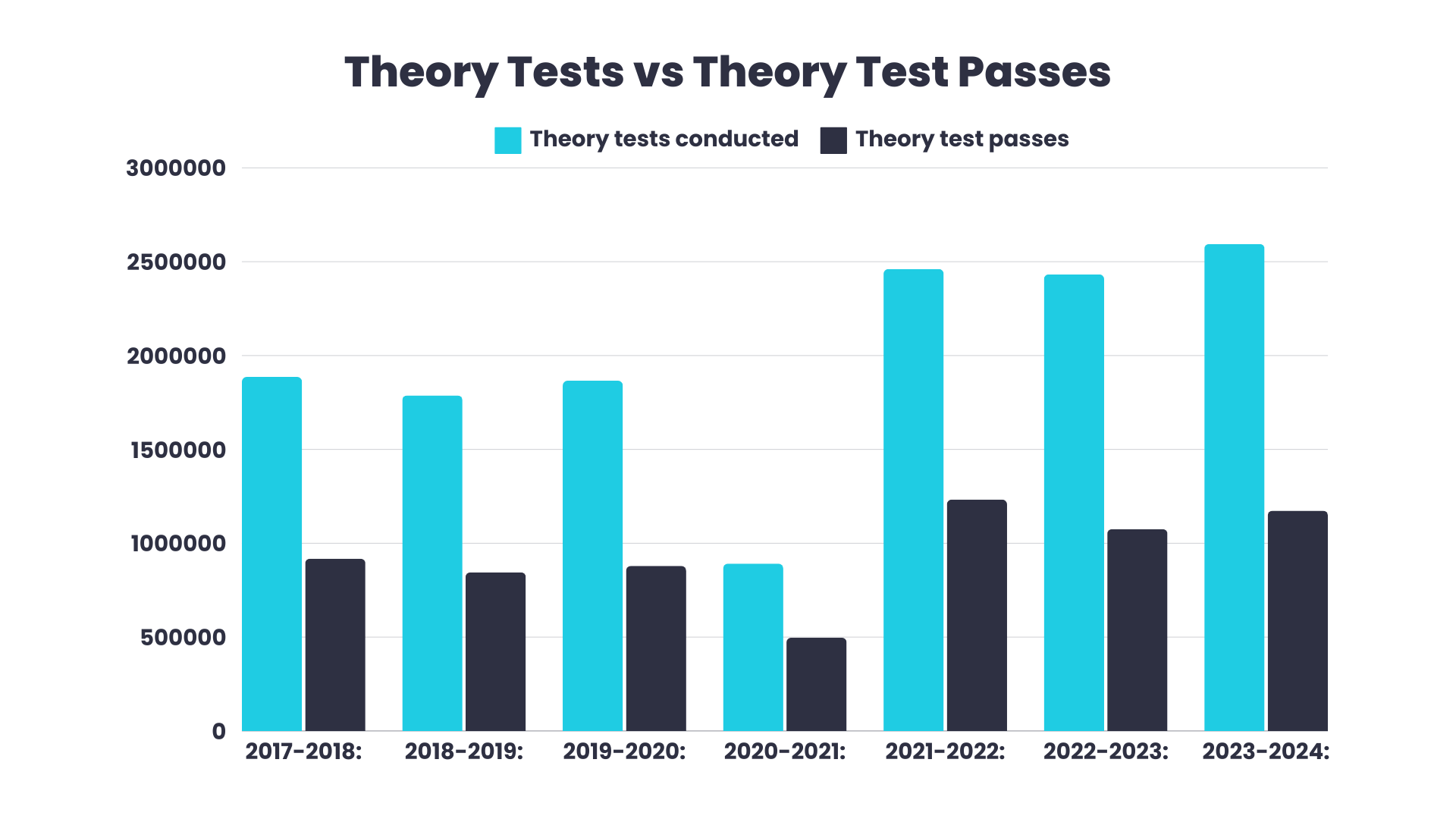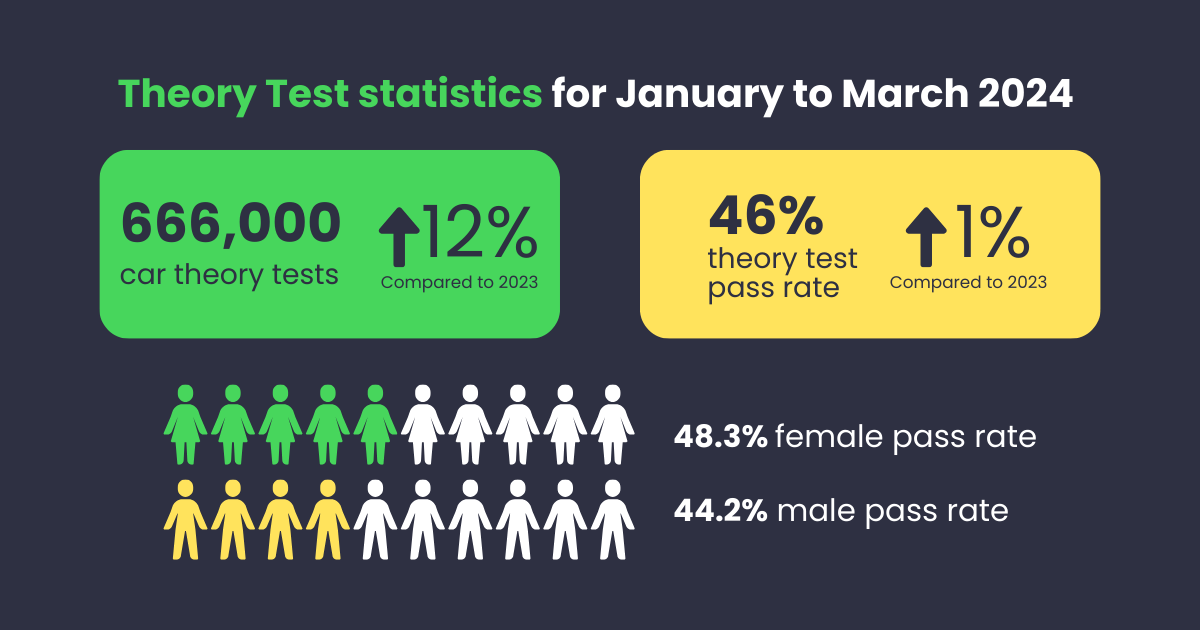
Do I Have to Pass My Theory Test Before Learning to Drive?
Find out whether you need to pass your theory test before you start learning to drive and what other requirements are needed.
Passing your driving theory test is the first essential milestone on the road to becoming a fully licensed driver. Many learner drivers underestimate the importance of thorough preparation, but with the right revision techniques, the test doesn’t have to be daunting. In fact, proper revision can turn the experience into a valuable learning opportunity that can potentially make you a more confident and safer driver in the long run. The theory test might not involve practical driving skills, however it ensures you have a solid understanding of the rules and principles that keep everyone safe on the road. It is also worth noting that you can’t book your practical test until you have passed your theory test.
The aim of this blog is to explore the most effective and widely used theory test revision methods, helping you find a strategy that fits your learning style. Whether you prefer traditional study methods, like reading books and making notes, or modern techniques such as using mobile apps or online quizzes, there’s an approach that will suit you. Alongside covering different revision methods, we’ll provide key tips and answers to frequently asked questions, ensuring you’re well-prepared to tackle your theory test and take the next step towards getting your full driving licence.
Learning to drive isn’t just about mastering practical skills behind the wheel; it also involves having a solid understanding of the rules of the road. The UK theory test assesses your knowledge of traffic signs, road rules, and safe driving principles. If you don’t revise properly, you risk missing crucial information that could be the difference between passing and failing your theory test.
It ensures you understand road signs and regulations: These are essential for safe driving, and the theory test checks your knowledge in these areas.
You develop hazard perception skills: This part of the test ensures you can identify and respond to hazards on the road, a critical skill for road safety.
You boost your confidence: Thorough revision can make you feel more prepared and potentially less anxious ahead of taking the driving theory test.

When revising for the theory test, it’s important to cover all the areas that could come up. Here’s a breakdown of the key topics:
Rules of the Road: These include general driving rules, speed limits, and the Highway Code, which governs how drivers should behave on the road.
Road Signs and Markings: You must recognise and understand various road signs, including warning, information, and directional signs, as well as road markings.
Hazard Perception: This tests your ability to spot potential hazards on the road. You’ll watch a series of video clips and must identify developing hazards to score points.
Driving Attitude: This includes understanding the proper behaviour for driving safely and respectfully towards other road users.
Vehicle Handling: Understanding how to handle a vehicle in various road conditions, including rain, fog, or ice, is crucial.
Safety and Your Vehicle: You’ll need to know about vehicle safety, such as seatbelt regulations and safety equipment like airbags and ABS brakes.
Motorway Rules: As motorways have specific rules and regulations, it’s vital to be familiar with these before taking your theory test.
The number of theory tests being carried out each year are increasing, with more and more young people learning to drive.
Source: https://www.gov.uk/government/statistical-data-sets/car-theory-test-data-by-test-centre/
There are numerous ways to revise for your theory test, and the key is to find a method that suits your learning style. Here are some of the most effective and common revision methods:
1. Theory Test Apps
Using mobile apps specifically designed for theory test revision is one method among learner drivers. Driving theory test apps are widely available for smartphones and tablets, providing an interactive and convenient way to study. Most apps offer a comprehensive package that includes mock theory tests, access to The Highway Code, and practise for the hazard perception test. One of the biggest advantages of using apps is their portability – you can revise anywhere, whether you’re commuting, sitting at home, or during a lunch break. Many apps also track your progress, helping you identify areas where you’re excelling and those that need further improvement. One great theory test app is RoadHow , who Collingwood Insurance have partnered with to help learner drivers improve their learning to drive experience.
Benefits:
Convenience: The ability to study anytime and anywhere makes it a perfect option for busy learner drivers who can’t always sit down for dedicated study sessions.
Progress tracking: Apps can track your progress over time, allowing you to focus on areas where you’re struggling, which maximises the effectiveness of your revision.
Variety of content: The interactive nature of apps keeps the content engaging, with quizzes, videos, and instant feedback making it easier to absorb information.
2. The Official Highway Code
The Highway Code remains one of the most reliable and essential resources for revising for your theory test. As the official guide for road users, it covers all the legal rules, regulations, and recommendations you need to know for the test and beyond. While it may not be as interactive as other revision methods, reading through the Highway Code is crucial for understanding the fundamentals. Many learners use this resource alongside other methods, making notes or highlighting key sections as they read. Whether you prefer the hard copy or the online version, this is a must-read for any learner driver.
Benefits:
Authoritative source: Since it’s an official publication from the UK government, you can be certain that all information is accurate and up to date.
Comprehensive coverage: The Highway Code doesn’t just help with the theory test – it teaches you the rules that will be vital when you’re driving on the road every day.
Great for in-depth understanding: Reading the full Highway Code ensures you gain a solid grasp of the rules, not just enough to pass the test but to become a safer, more informed driver.
3. Online Practice Tests
Mock tests are an incredibly effective way to simulate the real test environment and prepare for the types of questions you’ll face. Numerous websites offer free or subscription-based online practice tests, where you can work through a series of multiple-choice questions in the same format as the actual theory test. These practice tests are ideal for measuring your progress and highlighting any weak areas that require more attention. The more mock tests you take, the more familiar you’ll become with the structure of the exam, which will reduce any anxiety you may feel on the day of the real test.
Benefits:
Realistic practice: Mock tests are designed to closely replicate the structure and format of the actual test, making you feel more comfortable when the big day arrives.
Timed sessions: Most practice tests are timed, which allows you to get used to answering questions under pressure, mimicking the real test environment.
Immediate feedback: After completing a mock test, you’ll receive feedback on your answers, helping you quickly identify any knowledge gaps.
4. Hazard Perception Practice Videos
The hazard perception section of the theory test often proves tricky for many learner drivers, but practicing with hazard perception videos can greatly improve your performance. These videos simulate real-life driving scenarios, and your task is to click when you spot a developing hazard. You can find these videos on theory test websites, apps, or even on platforms like YouTube. By regularly practicing with these clips, you’ll sharpen your ability to recognise potential hazards quickly, which is a critical skill both for the test and when you’re on the road. Shift Driving School provide a great explanation of the Hazard Perception part of the theory test.
Benefits:
Improves reaction time: The more you practise, the quicker you’ll become at identifying hazards, which is essential for driving safely in real life.
Builds confidence: As you get better at recognising hazards during practice, your confidence will grow, making the test feel less intimidating.
Lifelong skill: The hazard perception skills you develop will be invaluable throughout your driving career, helping you stay safe on the road.
5. Study with Friends or Family
Studying with friends or family can be a fun and effective way to help you learn. You can quiz each other, chat about tricky topics, and share tips for revising. This works especially well if you like talking things through or find that explaining something to others helps it stick in your mind. You can meet up in person or even start a group chat online to share questions and ideas.
Benefits:
Collaborative learning: Studying with friends or family lets you share ideas and explain things to each other, which can make hard topics easier to understand.
Motivation: Working together keeps you motivated, as your friends can help keep you on track with your revision.
Boosts understanding: Talking about theory topics with others can help clear up anything that’s confusing when you’re studying on your own.
6. Flashcards
Flashcards are an effective revision tool, especially for memorising key facts like road signs, speed limits, or stopping distances. You can create your own flashcards, tailoring them to the areas where you need the most help, or use pre-made sets available online or through apps. Flashcards encourage active recall, a process where you challenge yourself to remember information, which helps strengthen your memory and improve retention.
Benefits:
Highly portable: You can take your flashcards anywhere, making it easy to revise even when you only have a few spare minutes.
Active learning: Flashcards encourage you to actively recall information rather than passively reading, which leads to better long-term retention.
Customisable: Creating your own flashcards lets you focus on the specific areas you need to improve, ensuring your revision is targeted.
7. Video Tutorials
For visual learners, video tutorials are a fantastic resource for explaining complex concepts in an easy-to-understand format. You can find educational videos on YouTube or driving theory websites, where instructors break down everything from road signs to hazard perception techniques. Some people find it easier to absorb information by watching demonstrations, as opposed to reading from a book or app.
Benefits:
Visual learning: Videos are perfect for learners who prefer seeing information explained step by step, rather than just reading about it.
Engaging format: The dynamic nature of video keeps things engaging, which is especially helpful if you find it hard to stay focused during traditional study sessions.
Breaks down complex topics: Complicated subjects like hazard perception or interpreting road signs are often easier to understand when presented visually.
8. Driving Theory Books
There are several comprehensive driving theory books available that cover everything from the Highway Code to practise questions and hazard perception. Books often provide detailed explanations of each section of the theory test and include mock tests at the end of chapters to help you check your understanding. Many learners find that reading from a book, as opposed to digital content, helps them absorb information better, especially when taking notes or highlighting key points.
Benefits:
In-depth revision: Driving theory books provide a deep dive into each topic, offering detailed explanations that go beyond simple question-and-answer formats.
Offline option: If you prefer not to rely on screens, books offer a valuable offline method for studying.
End-of-chapter quizzes: Many theory books include quizzes, allowing you to test your knowledge as you progress through the material.
As previously mentioned, we continue to see an increase in the number of theory tests carried out.
Source: https://www.gov.uk/government/statistics/driver-and-rider-testing-and-instructor-statistics-april-2023-to-march-2024/driver-and-rider-testing-and-instructor-statistics-april-2023-to-march-2024
Start Early: Don’t leave your revision until the last minute. Give yourself enough time to cover all areas thoroughly.
Create a Study Schedule: Break down the topics into manageable chunks and set a revision timetable. Consistent, focused sessions are more effective than cramming.
Take Regular Breaks: Your brain needs time to absorb information. Take a short break every hour or so to keep your mind fresh.
Use a Variety of Resources: Different learning tools help you retain information better. Use apps, books, and online quizzes to test your knowledge.
Stay Positive: It’s natural to feel overwhelmed but stay motivated and keep a positive attitude throughout your revision.
Focus on Weak Areas: After a few practice tests, you’ll notice which areas you’re struggling with. Spend more time revising these topics.
Use Memory Tricks: Try making up fun rhymes or shortcuts to help you remember tricky info, like stopping distances or what different road signs mean.
Revise Little and Often: Short, frequent revision sessions can be more effective than long, infrequent ones.
Simulate Test Conditions: When taking mock tests, try to replicate the real test environment by timing yourself and limiting distractions.
Stay Calm: Stress can impact your ability to recall information. Practise relaxation techniques to help stay calm during your revision and on test day.
Revising for your driving theory test doesn’t have to be overwhelming if you approach it with the right mindset and methods. By exploring a variety of revision techniques, whether it’s using mobile apps, reading the Highway Code, taking online practice tests, or studying with friends or family, – you can tailor your study sessions to fit your personal learning style. Remember, consistency is key, so start early, and revise regularly to build your knowledge and confidence. The theory test is not just about passing the exam; it’s about understanding the rules and principles that will make you a safer driver for life. With thorough preparation, you’ll be more than ready to tackle your theory test and move forward to the practical driving stage.
Sign up today for exclusive offers, practical guidance, driving tips, and more!

Commonly asked questions about Theory Tests
The pass mark for the multiple-choice section is 43 out of 50 questions. For the hazard perception test, you need to score at least 44 out of 75.
Once you pass your theory test, it is valid for two years. You need to pass your practical driving test within this period, or you will have to take the theory test again.
There are 50 multiple-choice questions in the theory test, and you need to answer at least 43 correctly to pass.
After passing your theory test, you can book and take your practical driving test. Ensure that you continue to practise your driving skills during this time.
Yes, if you don’t pass the theory test, you can retake it after three working days. Make sure to revise thoroughly before booking your next attempt.
You will be logged out in seconds. Do you want to stay signed in?